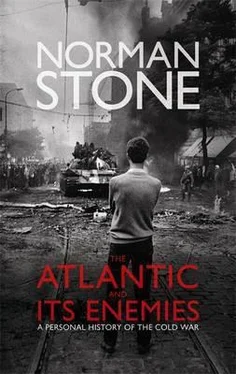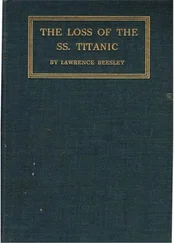Towards the end of the decade there was an international exhibition in Moscow, and the Americans showed off their kitchens. Vice-President Richard Nixon appeared, and there was a famous row between him and the Soviet leader, Nikita Khrushchev, who said that such things had nothing to do with justice or culture. Though he was not himself an expert in either field, a good part of the intelligentsia might have agreed with him. There was no question about it: Soviet high culture was far richer than American. There was now a Soviet challenge, in that the Soviet space effort appeared to be more successful than the USA’s where science, applied to space and weaponry, was concerned. Sputnik caused national alarm, and a new national effort by America (in Great Britain the alarm was similar if less effectual) was apparently needed. This coincided with a two-year slow-down in the economy, when it grew by 2 per cent and unemployment came close to 6 per cent, then thought excessive. These questions gave Kennedy his narrow margin at the end of 1960, and when he took over, early in 1961, ambitious academics advised as to how the challenge was to be met. There were some famous and influential books, and conservatism had a bad time. These new writers analysed problems, and often suggested easy-sounding solutions, one mark of the sixties. John Kenneth Galbraith’s Affluent Society (1957) noted that private people had money and governments none the less produced squalor: New York gorged with money, yet the roads were potholed and a good part of the population lived in poor conditions. Two decades later governments had a great deal more money and were still producing squalor: what conclusion was to be drawn, that governments should have even more, or that they just could not help producing squalor? Vance Packard’s Status Seekers (1960) described the American business rat race. Jane Jacobs, looking at the wreckage caused by the San Francisco freeway system, wrote The Death and Life of Great American Cities (1961) and she foresaw that housing estates for the poor would turn into sinks of hopelessness worse than the slums that they were to replace; she also foresaw that city centres would become empty, inhabited only by tramps. Betty Friedan’s The Feminine Mystique (1963) spoke for the bored housewife. Michael Harrington discovered that there were many poor Americans: The Other America (1962). David Riesman looked at the American rat race in The Lonely Crowd (1961) and shook his head at the two-dimensional misery of it all. René Dumont considered international aid, and thought that there should be much more of it; Gunnar Myrdal saw American race relations in the same light. Germaine Greer wrote The Female Eunuch (1970) saying that for women life was a bitter picture from the cradle to the tomb.
The answer was: spend money. Here, the presiding genius was Maynard Keynes. He had been contemptuous of the orthodox balance-the-budget financiers who had run things in the 1930s (and who were still running them in the 1950s): they reduced the National Debt and tried to run a budget surplus. An enlightened State, borrowing and spending, could easily be beneficial, especially if it helped poor people at the expense of the better-off. ‘Demand’ — the ability to buy — would stimulate supply, the provision of goods. It was just selfishness on the part of the rich that got in the way, and a measure of sheer stupidity. The great Slump of 1929 had discredited capitalism and especially bankers in many intelligent eyes, and Keynes had made easy conquests of intelligent young men and women, who would probably have agreed with the grandfather of a well-known Italian journalist, Indro Montanelli, in the sentiment that ‘it is possible for an honest man to have dealings with whores, but with bankers, never’. If making life better for people beyond the prosperous circles of the fifties meant spending money, then that was a worthy cause. Galbraith had been involved in price control during the Second World War and never did understand why his critics regarded the State as wasteful, corrupt and inefficient. The war economy had been extraordinarily successful, thought he and his like: even petrol rationing, which made life very difficult in the more isolated places, had been very widely accepted. Why bother with out-of-date economic rules?
Economists of the younger generation were convinced that they were the legislators for mankind, and even that they had abolished all problems. Keynes himself would never have agreed with this, but his younger disciples, among them splendid writers such as Galbraith, did not have doubts. Economists were the Druids of the age, and the message that, overall, they gave was very comforting: if governments spent money, problems would be solved and the good life (whatever that meant) would duly happen. As a profession, economists had been rather caught out in the interwar Slump, because they had preached austerity and virtue — saving, cuts in welfare spending. That had not cured the Slump — far from it, at least in the popular mind. On the contrary, it had worsened matters, to the point where, in Germany, Hitler came to power. Galbraith wrote a book on the Slump that blamed bankers, and it was a bestseller. Now, economists were associated, on the whole, with easy answers. How widespread their effect was can be seen from an aside by the English historian A. J. P. Taylor, in his book about the origins of the Second World War. Hitler’s economy had produced mild inflation, he said, and had thereby produced full employment in a country that, in 1933, had had 8 million men out of work; Taylor added that everyone now knew that mild inflation was a cause for prosperity. A dozen years after writing this, when, nearing old age, he saw his savings consumed by inflation, and the streets outside scattered with litter, he told a different story. But the essence of the sixties was a belief that there were easy answers, so long as grumbling old men got out of the way. Kennedy was inspired by Roosevelt, but the ghost of Keynes stalked his corridors (although when Keynes met Roosevelt in the 1930s, and tried to discuss his theory, the meeting was not a success). It is strange, looking back, how easy the solutions appeared to be. Cambridge, where Keynes had reigned, was still the leading centre in the world for economics, and one of the few dissidents with a sense of publicity, the young Milton Friedman, from Chicago, went there for a spell. He was a good mathematician, and his work might have proved useful to the economists there. Instead, he was in effect frozen out by a grand old dame of Cambridge economics, Joan Robinson (who padded around King’s College in a bizarre Chinese peasant costume: but she was the daughter of a reactionary general who had fallen foul of Lloyd George in 1918, and the granddaughter of a considerable Victorian poet). There were of course dissident voices, but they were few, and they were unfashionable. Milton Friedman published a key article, ‘The Quantity Theory of Money’, which warned that there was a danger of inflation with the then current practices. He was waved aside, and when in the early 1960s Alan Walters — much later on, a recognized authority on both sides of the Atlantic — applied for a grant to develop statistics as to how much money was being created in England, he was turned down. At the time, economists were fighting their last war, in this case against unemployment, and an engineer-turned-economist, Alban Phillips, who had worked on a long run of data, produced one of the great symbols of the decade, the Phillips Curve. Wage rises and unemployment were related, with only one variable, import costs (as in the Korean War). In England, welfare benefits stopped wages from falling too low, and so demand for goods was kept up; government must surely maintain that demand to the point at which unemployment would never rise above 2.5 per cent. That way, there would be price stability, and men such as Alan Walters, wanting to make complicated calculations as to how much credit there was in the system were simply wasting time. The Phillips Curve dominated academic economics (or ‘discourse’). If anything went wrong, ran a further assumption, then price controls could be used — after all, they had been so used during the war, and operated, even by J. K. Galbraith. In ultra-prosperous Sweden, prices and wages were controlled by law. Why not elsewhere? So the economists, on the whole, assumed that they either had the answers or would have them.
Читать дальше












![Edward Ellis - Adrift on the Pacific - A Boys [sic] Story of the Sea and its Perils](/books/753342/edward-ellis-adrift-on-the-pacific-a-boys-sic-s-thumb.webp)